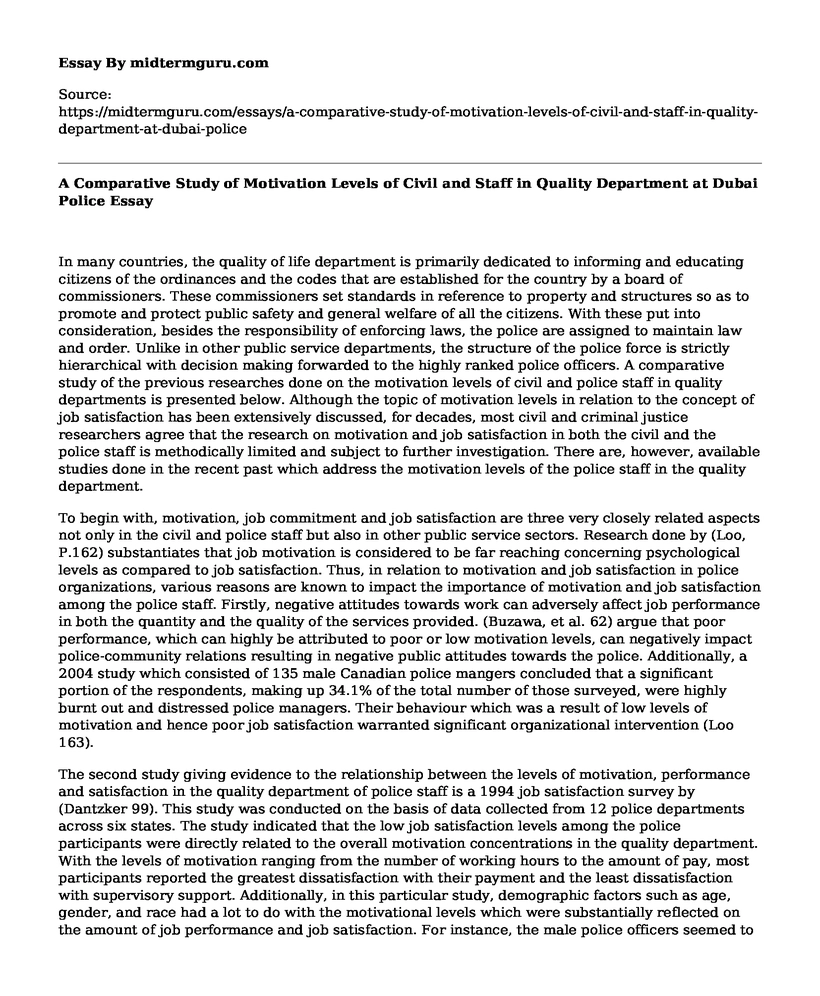In many countries, the quality of life department is primarily dedicated to informing and educating citizens of the ordinances and the codes that are established for the country by a board of commissioners. These commissioners set standards in reference to property and structures so as to promote and protect public safety and general welfare of all the citizens. With these put into consideration, besides the responsibility of enforcing laws, the police are assigned to maintain law and order. Unlike in other public service departments, the structure of the police force is strictly hierarchical with decision making forwarded to the highly ranked police officers. A comparative study of the previous researches done on the motivation levels of civil and police staff in quality departments is presented below. Although the topic of motivation levels in relation to the concept of job satisfaction has been extensively discussed, for decades, most civil and criminal justice researchers agree that the research on motivation and job satisfaction in both the civil and the police staff is methodically limited and subject to further investigation. There are, however, available studies done in the recent past which address the motivation levels of the police staff in the quality department.
To begin with, motivation, job commitment and job satisfaction are three very closely related aspects not only in the civil and police staff but also in other public service sectors. Research done by (Loo, P.162) substantiates that job motivation is considered to be far reaching concerning psychological levels as compared to job satisfaction. Thus, in relation to motivation and job satisfaction in police organizations, various reasons are known to impact the importance of motivation and job satisfaction among the police staff. Firstly, negative attitudes towards work can adversely affect job performance in both the quantity and the quality of the services provided. (Buzawa, et al. 62) argue that poor performance, which can highly be attributed to poor or low motivation levels, can negatively impact police-community relations resulting in negative public attitudes towards the police. Additionally, a 2004 study which consisted of 135 male Canadian police mangers concluded that a significant portion of the respondents, making up 34.1% of the total number of those surveyed, were highly burnt out and distressed police managers. Their behaviour which was a result of low levels of motivation and hence poor job satisfaction warranted significant organizational intervention (Loo 163).
The second study giving evidence to the relationship between the levels of motivation, performance and satisfaction in the quality department of police staff is a 1994 job satisfaction survey by (Dantzker 99). This study was conducted on the basis of data collected from 12 police departments across six states. The study indicated that the low job satisfaction levels among the police participants were directly related to the overall motivation concentrations in the quality department. With the levels of motivation ranging from the number of working hours to the amount of pay, most participants reported the greatest dissatisfaction with their payment and the least dissatisfaction with supervisory support. Additionally, in this particular study, demographic factors such as age, gender, and race had a lot to do with the motivational levels which were substantially reflected on the amount of job performance and job satisfaction. For instance, the male police officers seemed to be more motivated and portrayed higher job satisfaction levels as compared to their female counterparts. On the other hand, police officers and other civil workers between the ages of 20 and 25 demonstrated more satisfaction in their job at different quality departments as compared to other officers in other age groups. Lastly, race and ethnicity were the other demographic factors which substantiated the diversities in job satisfaction as a result of the difference in levels of motivation. For instance, in this particular study, African-American police officers demonstrated a lot of motivation and consequently greater job satisfaction as compared to their white counterparts.
Works Cited
Buzawa, A., Austin, T., & Bannon, J. "The role of selected socio-demographic and job-specific variables in predicting patrol officer job satisfaction: A re-examination ten years later." American Journal of Police, vol. 13, no. 2, 1994, pp. 51-75.
Dantzker, M. L. "Measuring job satisfaction in police departments and policy implications: An examination of a mid-size, southern police department." American Journal of Police, vol. 13, no.2, 1994, pp. 77-101. Accessed 17 Jan. 2017.
Loo Robert. A typology of burnout types among police managers. Poling: An International Journal of Police Strategies & Management, vol. 27, no.2, 2004, pp. 156-165.
Cite this page
A Comparative Study of Motivation Levels of Civil and Staff in Quality Department at Dubai Police. (2021, May 28). Retrieved from https://midtermguru.com/essays/a-comparative-study-of-motivation-levels-of-civil-and-staff-in-quality-department-at-dubai-police
If you are the original author of this essay and no longer wish to have it published on the midtermguru.com website, please click below to request its removal:
- Servant Leadership in Nursing Team
- Key Elements of a Strong or Positive Organization Culture and Diversity Management - Papaer Example
- Essay on General Electrics Online Marketing Service and New Development in Online Service
- Essay Sample on Effective Communication and Teamwork in Regards to Ideas From Johari Window
- Essay Sample On Behavior, Perspective, and Advice on Leadership
- Essay Sample on Leadership: Influence, Power, Tactics - Connecting the Dots
- The Success of an Organization: Balancing Stakeholder & Management Roles - Essay Sample







